 |
|||||||||||||||||
|
Luxor was our first stop on our tour to Egypt in January, 2003. It is an area on the Nile in Upper Egypt that has many tombs and temples. The city was built in the ruins of ancient Thebes and was the capital of the New Kingdom (about 1567-1085 BC). In this area lies the Valley of the Kings, Luxor Temple, and the Temple of Karnak, making it a treasure-trove for lovers of antiquities. Most of these were hidden until the 1800s after Napoleon’s expedition to Egypt.
Next on our itinerary was a visit to Deir el-Bahri (left), or temple of Hatshepsut (the only woman to rule over Egypt as a pharaoh), quite imposing as it sits at the base of massive crags forming the Theban Hills. The colonnade give a grand appearance to the temple. The proportions are so immense it is difficult to imagine without being there to see it. Several colorful reliefs are still visible along the back walls behind the columns. On the way out, we made our perfunctory shopping stop, this time at an alabaster shop. There were several young men out front, demonstrating how the alabaster is carved by hand, which was interesting to watch (below left). The one farthest right makes a whole in the center of the rock using a grinding tool, the next cuts the basic shape, and the last does the fine work. These hand-carved pieces are truly beautiful, much more so than the machine manufactured pieces. The vases that are made are carved so thinly that they become opaque.
When we were all aboard, the boater came to the rear to pull-start the outboard motor, but of course everyone at the back of the boat had to get up to give him enough room to get it started. Then another boater pushed us off while our driver reversed, although nothing happened - too much weight up front! All the big guys had to move to the rear and we were finally able to shove off. Then our driver come around to the next boat where the boater on shore prepared to jump from the roof of that boat to our boat. As we watched this, our driver now climber to the roof of our boat and jumped from our boat to the other, leaving us momentarily with no one operating the boat. All turned out well in the end and we safely made it to the other side. On to the Temple of Luxor where we stared in awe at the magnificent buildings and columns (below right). The scale is enormous, the workmanship superb, and the quantity overwhelming. It truly is difficult to describe the sense of awe this place produces. You just have to stand and stare at the wonder of it all. From the smallest detail to the largest column, it is truly amazing. The photo at left shows some carved detail that has been somewhat protected from the climate and therefore preserved better than most.
You can walk for days in Karnack and probably not see it all. Even if you did see it all, you couldn’t take it all in. There is simply too much. Besides the Hall, there are several other courts and smaller temples, obelisks, colossi, and a sacred lake. Our guide book suggested at least 2-4 hours. We spent barely an hour covering the highlights. The entire complex covers some 62 acres.
Just getting to the lunch stop was a treat for most - the road was too narrow for the bus to turn around where the restaurant is, so the bus driver make a U-turn about 1/4 mile down the road (it took him 3 turns to do it) with traffic backing up in both directions. Finally turned, he then backed up the 1/4 mile to the restaurant into the on coming traffic. We actually made it without any mishaps, so we guess we shouldn’t complain too much. Following lunch we joined a convoy of busses to Esna. We were not quite sure why the convoy, but we think it was for security. There are many highway checkpoints each with armed police. Gives you a real sense of safety, yes? We board our boat in Esna, as it has spent the day traveling to this point and has already passed through the locks. To see additional photos of the Valley of the Kings, click here. To see additional photos of Deir el-Bahir, click here. To see more photos of the Temple of Luxor, click here. To see more pictures from the Temple of Karnak, click here. |
|||||||||||||||||
|
If you find typographical errors or have any other problems when looking at the site please contact the Webmaster describing the problem and the page involved. |
|||||||||||||||||
|
Copyright © 2000-2009 Jim Seavey and Verna Norris All Rights Reserved |
|||||||||||||||||
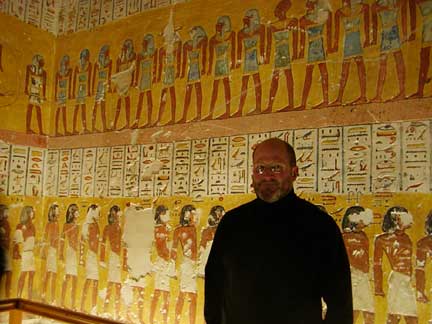
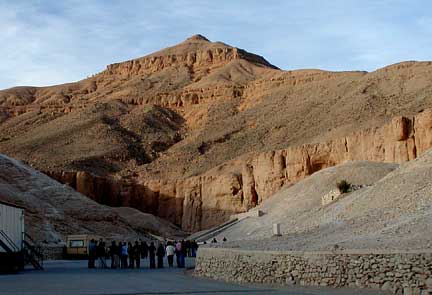
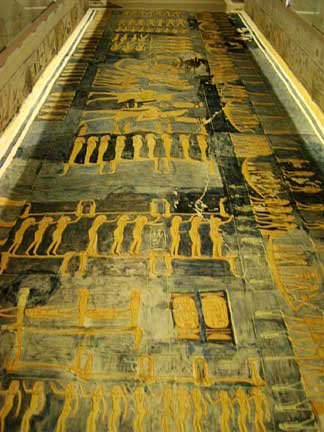 Obviously a huge amount of manual labor went into first excavating the tombs (some reach into the hillside as far as 80 meters - 250 feet), then carving and painting the walls and ceiling, not to mention making the huge sarcophagi as well. Huge walls of hieroglyphics told the story of each Pharaoh’s life. It appears that the walls are “plastered” then carved and painted, as the plastering has chipped away from several places in large chunks (as in the above left picture in the tomb of Ramses IV) The colors remain quite vivid. The yellow/black ceiling in Ramses IX is particularly outstanding (right). Also, a dark color ceiling with white or yellow stars seems to be a favorite motif found in many tombs, signifying the night sky.
Obviously a huge amount of manual labor went into first excavating the tombs (some reach into the hillside as far as 80 meters - 250 feet), then carving and painting the walls and ceiling, not to mention making the huge sarcophagi as well. Huge walls of hieroglyphics told the story of each Pharaoh’s life. It appears that the walls are “plastered” then carved and painted, as the plastering has chipped away from several places in large chunks (as in the above left picture in the tomb of Ramses IV) The colors remain quite vivid. The yellow/black ceiling in Ramses IX is particularly outstanding (right). Also, a dark color ceiling with white or yellow stars seems to be a favorite motif found in many tombs, signifying the night sky.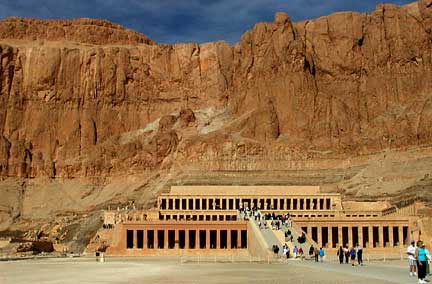 The entire valley is covered with these tombs and they continue to dig for more. There was a team on site doing an excavation next to Ramses III. It appears to be a European or North American archeologist with local workers. One supervisor for the laborers, 2 who actual broke ground with their picks while watching for any traces of finds, then a larger group which filled baskets with the rubble and poured these into a waiting trailer to be hauled away. Very labor intensive work which hasn’t changed much over several thousands of years.
The entire valley is covered with these tombs and they continue to dig for more. There was a team on site doing an excavation next to Ramses III. It appears to be a European or North American archeologist with local workers. One supervisor for the laborers, 2 who actual broke ground with their picks while watching for any traces of finds, then a larger group which filled baskets with the rubble and poured these into a waiting trailer to be hauled away. Very labor intensive work which hasn’t changed much over several thousands of years.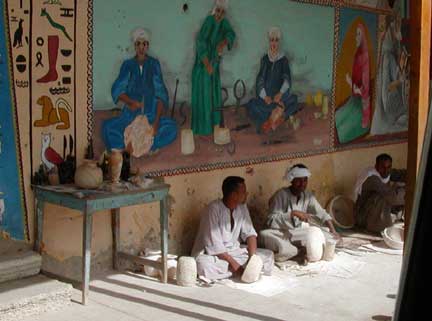
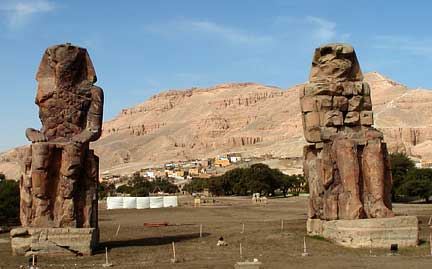
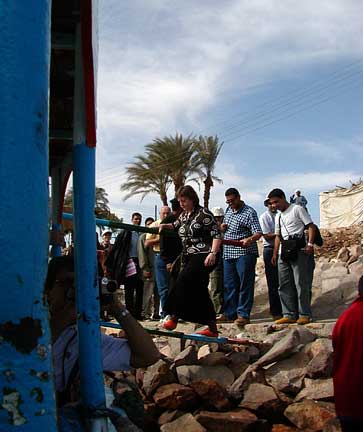 As if this wasn’t enough, we then rode across the Nile in one of the local passenger ferries to visit some temples. The picture here(below, right) shows our boarding ramp - a board laid across the rocks to the boat, then a heavy pole held by the boater and our guide Mohammed at either end to serve as a hand rail. What, me worry? Oh, and a life jacket for every passenger - NOT!
As if this wasn’t enough, we then rode across the Nile in one of the local passenger ferries to visit some temples. The picture here(below, right) shows our boarding ramp - a board laid across the rocks to the boat, then a heavy pole held by the boater and our guide Mohammed at either end to serve as a hand rail. What, me worry? Oh, and a life jacket for every passenger - NOT!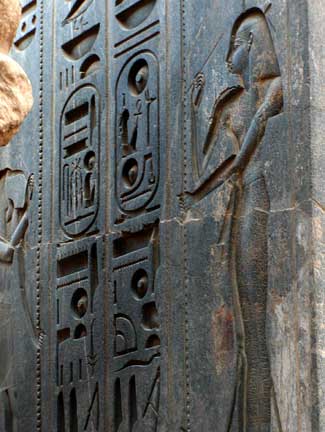
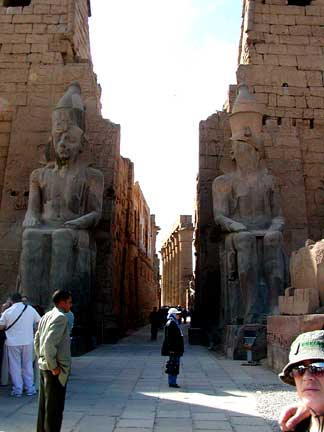
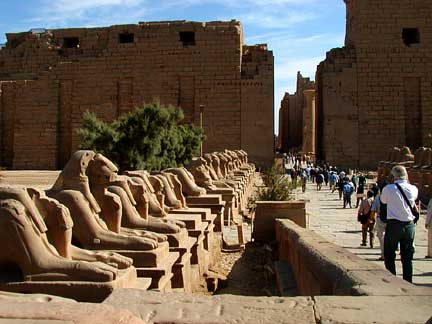 The Great Hypostyle Hall is Karnak’s glory. With 134 columns, the largest colonnade in the world, it covers 6000 square meters. Each column is massive and covered from top to bottom with carved relief (below).
The Great Hypostyle Hall is Karnak’s glory. With 134 columns, the largest colonnade in the world, it covers 6000 square meters. Each column is massive and covered from top to bottom with carved relief (below). 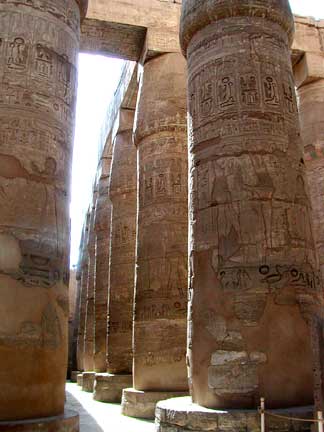 Now, finally, a much-needed break. We headed for lunch at a local restaurant. A buffet with variety, from salads to spaghetti, rice, beans, chicken, fish and an assortment of desserts. At our table, we tried all the desserts and agrees that about 1/2 of them had no flavor of any kind. They were somewhat sweet with varying textures (3 jellied, 1 fried, 1 shredded filo pastry, and one with layers of filo) but the flavor was a bit on the weak side. Probably the best choice was the fresh dates.
Now, finally, a much-needed break. We headed for lunch at a local restaurant. A buffet with variety, from salads to spaghetti, rice, beans, chicken, fish and an assortment of desserts. At our table, we tried all the desserts and agrees that about 1/2 of them had no flavor of any kind. They were somewhat sweet with varying textures (3 jellied, 1 fried, 1 shredded filo pastry, and one with layers of filo) but the flavor was a bit on the weak side. Probably the best choice was the fresh dates.